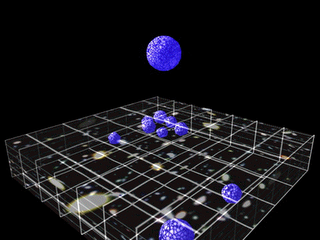
When I was young I tought that science was concerned with the ultimate nature of reality. It was a long road before I realized that reality is a complicated concept that inhabits the realm of philosophy. Sometime ago, when I was reading about braneworlds, I thought about a situation that can illustrate it quite well.
Imagine that the universe contains two branes that, by hypothesis, do not interact in any way. Each brane has a set of physical laws that enables the development of intelligent life. Let us say that we humans live in one of these branes. As there is no interaction (and will never be) with beings in the other brane, their existence is something that science is not concerned with. Indeed, as the hypothesis of their existence is not falsifiable, it is ruled out as science by its the very definition. Of course our science cannot deny our existence, but as the situation of both branes is symmetric, for the scientists of the other brane talking about our existence is also unscientific. If you take by heart Descartes' Cogito ergo sum, then both civilizations exist but only for themselves, the existence of one to the other is not a scientific hypothesis in each brane. And it is not just about the civilizations, but the non-interaction effect rules out the entire brane from the scientific realm of the other.
A friend with whom I talked about this told me that it is similar to the traditional paradox of the tree falling without nobody to watch, but the brane paradox above is more deep, because the tree can in principle leave traces of its fall, but the branes cannot sense the existence of each other by hypothesis!
Well, that is why I started to study a little philosophy in addition to physics. Although it may be not falsifiable, the nature of reality is an interesting question and I remember that, when I was a child, curiosity was the true feeling that led me to choose to be a scientist.
By the way, today is another Holy Day for physics, maybe even holiest than the day of my last post. In this day, in 1687, Philosophiae Naturalis Principia Mathematica (which appeared in the Da Vinci Code depicted as a book about astronomy and gravity :) ) was first published by Isaac Newton. We can say in a certain way that, for physics, this was the book (an the man) that really started it all in the way we know it today.
Picture: http://www.nevis.columbia.edu/~conrad/visuals/hep_images.html
Imagine that the universe contains two branes that, by hypothesis, do not interact in any way. Each brane has a set of physical laws that enables the development of intelligent life. Let us say that we humans live in one of these branes. As there is no interaction (and will never be) with beings in the other brane, their existence is something that science is not concerned with. Indeed, as the hypothesis of their existence is not falsifiable, it is ruled out as science by its the very definition. Of course our science cannot deny our existence, but as the situation of both branes is symmetric, for the scientists of the other brane talking about our existence is also unscientific. If you take by heart Descartes' Cogito ergo sum, then both civilizations exist but only for themselves, the existence of one to the other is not a scientific hypothesis in each brane. And it is not just about the civilizations, but the non-interaction effect rules out the entire brane from the scientific realm of the other.
A friend with whom I talked about this told me that it is similar to the traditional paradox of the tree falling without nobody to watch, but the brane paradox above is more deep, because the tree can in principle leave traces of its fall, but the branes cannot sense the existence of each other by hypothesis!
Well, that is why I started to study a little philosophy in addition to physics. Although it may be not falsifiable, the nature of reality is an interesting question and I remember that, when I was a child, curiosity was the true feeling that led me to choose to be a scientist.
By the way, today is another Holy Day for physics, maybe even holiest than the day of my last post. In this day, in 1687, Philosophiae Naturalis Principia Mathematica (which appeared in the Da Vinci Code depicted as a book about astronomy and gravity :) ) was first published by Isaac Newton. We can say in a certain way that, for physics, this was the book (an the man) that really started it all in the way we know it today.
Picture: http://www.nevis.columbia.edu/~conrad/visuals/hep_images.html

3 comments:
Bom, talvez o criterio de falsibilidade de Popper seja um pouco restritivo demais. Acho que se precisa de uma nova categoria, "especulação científica". Muito do que é publicado no PRL é "especulação científica", branas inclusive. Alamino, passe no SEMCIENCIA e assine o abaixo assinado pro Estadao, se quiser.
Alamino,
Gostei muito deste post, e gostaria de comenta-lo no SEMCIENCIA. Nao teria jeito de vc fazer uma versao portuguesa do mesmo e postar lá, pra depois eu fazer um post referente a ele?
Claro, Osame. Sera um prazer. Mas, como sempre, ele vai aparecer sem acentuacao...
Post a Comment